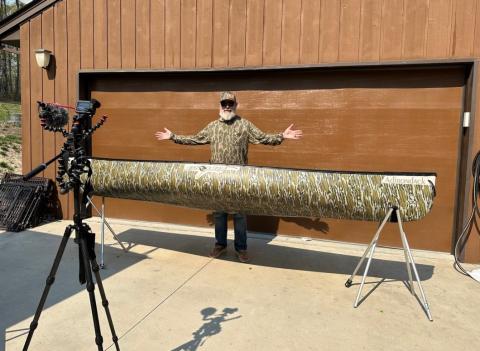Greg Tinsley
Future sociologists may discuss declines in the popularity of jonboats during conferences dedicated to How It All Went Wrong. Great civilizations rise and fall within sight of their boatyards, and certainly the attractiveness, the achievements, of the All-American skiff began to fade in the early 1980s.
Perhaps it was that the fun, the prestige, the freedom and the fishing-and-hunting effectiveness of the reasonably priced jonboat gradually became underestimated. Energy and raw-material costs rose. Manufacturing consolidations occurred. Consumer aspirations both expanded and narrowed. G-Paw aged out.
None of which will ever completely overshadow the small metal boat’s exclusive niche power and perpetual country-boy appeal. You see: The utilitarian jonboat provides 100-percent more hunt-fish pizzazz than no boat at all. Thus, new or used, the value-rich, historically cool jonboat holds a unique position across all of time.
For instance, the French constructed a fleet of flat-bottom woodies 265 years ago to launch an invasive marine strike on the British, and songwriter David Garrick mentions this boat design in his 1759 ditty titled “Heart of Oak.”

Americans Lewis and Clark utilized flat-bottoms in their Corps of Discovery. In his Seventies, the elderly Daniel Boone was seen solo polling a cumbersome flatboat loaded with green hides to the wharves of Saint Louis. And by the late 1800s, the world epicenter for flat-bottoms was America’s heartland, specifically the Missouri Valley, the Ozarks.
In 1825 (from fur trapping’s parallel universe), an inquisitive Danish physicist identified trace aluminum hidden in rock and dirt. Super abundant and fantastically concealed – aluminum, it seemed, which is almost never found as a free metal, was soon revealed as the third most common element on earth behind oxygen and silicon. Sixty years later, engineers in France and America, working independently in 1886, broke the code on the metal’s final industrial processes, which lifted aluminum to everyday life.
But aluminum’s first works were in revolutionizing lightweight canteens for the soldiers of WWI, global packaging and transportation. Ultimately to include boatbuilding and spaceflight.
Grumman never made jonboats, per se. However, in addition to legendary flying machines – the Gulfstream business jet, the F-14 Tomcat and the lunar lander – this iconic American aerospace company did begin making stress-skinned aluminum canoes and sport boats in 1944.
Other brands have come and gone, including the aluminum jonboats of Clifton Miller’s Fisher Marine, vessels that first rolled off the production floor for national distribution in 1967, direct from West Point, Mississippi. That’s also the coincidental hometown of Mossy Oak Brand Camo, which was founded two years before Miller sold Fisher to the Brunswick Corporation in 1988. Eventually, Fisher became part of the Tracker-by-Bass-Pro-Shops bloodline.

I am the honored caretaker of a clean Miller original, which I bought at discount from my son using the old-man promo code. Dimensionally, this Fisher is more like a flat-bottom, square-jawed Grumman sport than today’s mainly wider jonboats. An artlessly homemade casting deck and back floor of water-resistant plywood was added to better accommodate some standing to fish. The skimmer’s primary screw is a strong 9.9-horse artefact from the early ‘60s.
While the balance point is a study in goosy, she will draft on a raindrop.
And, so, with kids looping feathered hooks to gurgling redfish from her bow, the Miller soon once more supplies the kind excitement for which she was conceived. Up razor-thin Gulf Coast tidal creeks, between margins of muddy shell bars, the kids will also experience unique birds, reptiles and insects – beasts that harken accounts and descriptions of dinosaurs.
Remote, spirited, small-craft adventuring through sawgrass flats beneath building skies. Floating a premier shoal-bass river. Bluegills on golden pond.
The Extraordinary Theory of the Jon is the collective dream that generations of up-and-comers will cycle again and again through that same old aluminum hull.



























